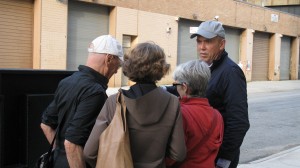From Yale to Jail, and Back

 Meander 8, 2011-14, oil enamel and oil on powder coated steel, 10 x 6 inches
Meander 8, 2011-14, oil enamel and oil on powder coated steel, 10 x 6 inches Meander 13, 2011-14, oil enamel and oil on powder coated steel, 10 x 6 inches
Meander 13, 2011-14, oil enamel and oil on powder coated steel, 10 x 6 inches Meander 11, 2011-14, oil enamel and oil on powder coated steel, 10 x 6 inches
Meander 11, 2011-14, oil enamel and oil on powder coated steel, 10 x 6 inches Meander 4, 2011-14, oil enamel and oil on powder coated steel, 10 x 6 inches
Meander 4, 2011-14, oil enamel and oil on powder coated steel, 10 x 6 inches Meander 7, 2011-14, oil enamel and oil on powder coated steel, 10 x 6 inches
Meander 7, 2011-14, oil enamel and oil on powder coated steel, 10 x 6 inches Meander 6, 2011-14, oil enamel and oil on powder coated steel, 10 x 6 inches
Meander 6, 2011-14, oil enamel and oil on powder coated steel, 10 x 6 inches
In 1973, as a Yale freshman, I studied art history and planned on becoming MoMA’s director. From the age of eight, Artforum, Art in America, and Art News were my “comic books.” I read the articles, one-word-at-a-time, until I understood Lawrence Alloway, Max Kozloff, et al. Spring 1974, Kozloff taught a graduate seminar in art criticism. I talked my way in and was accelerated beyond my capacity to comprehend. The result: I thought that Yale had little to teach me. I spent my time making a model boat, from scratch.
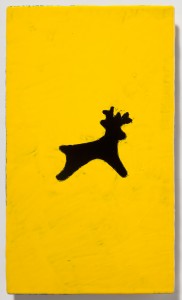 Winter 2, 2009, oil enamel on sandblasted steel, 10x6 inches
Winter 2, 2009, oil enamel on sandblasted steel, 10x6 inches Winter 3, 2009, oil enamel on sandblasted steel, 10x6 inches
Winter 3, 2009, oil enamel on sandblasted steel, 10x6 inches Winter 4, 2009, oil enamel on sandblasted steel, 10x6 inches
Winter 4, 2009, oil enamel on sandblasted steel, 10x6 inches Winter 3
Winter 3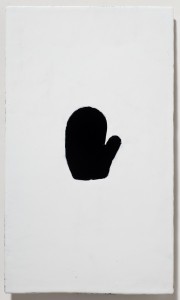 Winter 1, 2009, oil enamel on sandblasted steel, 10x6 inches
Winter 1, 2009, oil enamel on sandblasted steel, 10x6 inches Winter 6
Winter 6 Winter 7, 2009, enamel on sandblasted steel, 10x6 inches
Winter 7, 2009, enamel on sandblasted steel, 10x6 inches Winter 8
Winter 8
I was kicked out and returned home to Kansas City. After weeks of watching The Price Is Right, I decided to get a job. I washed dishes and drove a truck, before being offered and taking the assistant’s job at my family’s contemporary art gallery. It opened, in 1970, an outgrowth of my mother’s collecting, which began after our grand tour of Europe, in 1963; which, at age 7, was pivotal for me, too. She focused on small, American paintings. A Fairfield Porter, a David Park and two Warhol Flowers were her early purchases.
 Spring 7, 2010, enamel on sandblasted steel. 10x6 inches
Spring 7, 2010, enamel on sandblasted steel. 10x6 inches Spring 4, 2010, oil enamel on sandblasted steel. 10x6 inches
Spring 4, 2010, oil enamel on sandblasted steel. 10x6 inches Spring 3, 2010, oil enamel on sandblasted steel. 10x6 inches
Spring 3, 2010, oil enamel on sandblasted steel. 10x6 inches Spring 2
Spring 2 Spring 1, 2010, oil enamel on sandblasted steel. 10x6 inches
Spring 1, 2010, oil enamel on sandblasted steel. 10x6 inches Spring 5
Spring 5 Spring 2, 2010, oil enamel on sandblasted steel. 10x6 inches
Spring 2, 2010, oil enamel on sandblasted steel. 10x6 inches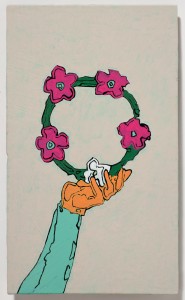 Spring 6
Spring 6
At 19, with a steady job, I found an apartment and began to make things. I thought they should be practical. Liking the chairs on display at MoMA, I made one after Gerrit Rietveld’s, and several others, too. Yet, all of them shared a certain difficult-to-sit-on quality. Realizing that I was using the rationale of practicality as an excuse to make sculpture, I apprenticed myself to a sculptor, in Kansas City, and took classes, from his assistant, at Kansas University. When I was 20, by adding a needed narrative to a sculpture, I unwittingly began to paint.
 Fall 1, 2010, oil enamel on powder coated steel, 10x6 inches
Fall 1, 2010, oil enamel on powder coated steel, 10x6 inches Fall 3, 2010, oil enamel on powder coated steel, 10x6 inches
Fall 3, 2010, oil enamel on powder coated steel, 10x6 inches Fall 3
Fall 3 Fall 1, 2010, enamel on powder coated steel, 10x6 inches
Fall 1, 2010, enamel on powder coated steel, 10x6 inches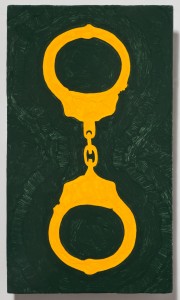 Fall 5
Fall 5 Fall 2, 2010, enamel on powder coated steel, 10x6 inches
Fall 2, 2010, enamel on powder coated steel, 10x6 inches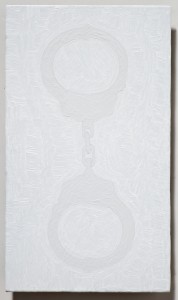 Fall 2, 2010, oil enamel on powder coated steel, 10x6 inches
Fall 2, 2010, oil enamel on powder coated steel, 10x6 inches Fall 4, 2010, oil enamel on powder coated steel, 10x6 inches
Fall 4, 2010, oil enamel on powder coated steel, 10x6 inches
My twenties, though, were a mess. As they wound down, I was told, authoritatively, that my family’s social prominence had prevented social services from rescuing me from my parents’ neglect. It was what I had known. It makes no sense that I was given lavish externals and, surprisingly, nothing internally. No one regrets that more than I do. Nevertheless, there were consequences to pay and I paid them. At 28, I was in federal prison, where I remained for four years.
 The Colored Squares Final Composite, 1986 - 2008, ink on paper, 52 x 84 inches
The Colored Squares Final Composite, 1986 - 2008, ink on paper, 52 x 84 inches The Colored Squares Strip Composite, 1986 - 2008, ink on paper, 8 1/2 x 84 inches
The Colored Squares Strip Composite, 1986 - 2008, ink on paper, 8 1/2 x 84 inches Squares Red, 1986, ink on paper, 8 1/2 x 14 inches
Squares Red, 1986, ink on paper, 8 1/2 x 14 inches Squares Orange, 1986, in on paper, 8 1/2 x 14 inches
Squares Orange, 1986, in on paper, 8 1/2 x 14 inches Squares Yellow, 1986, ink on paper, 8 1/2 x 14 inches
Squares Yellow, 1986, ink on paper, 8 1/2 x 14 inches Squares Green, 1986, ink on paper, 8 1/2 x 14 inches
Squares Green, 1986, ink on paper, 8 1/2 x 14 inches Squares Blue, 1986, ink on paper, 8 1/2 x 14 inches
Squares Blue, 1986, ink on paper, 8 1/2 x 14 inches Squares Violet, 1986, 8ink on paper, 8 1/2 x 14 inches
Squares Violet, 1986, 8ink on paper, 8 1/2 x 14 inches
In jail, I was offered the job of painting a mural. I overcame my desire, for evermore artistic exposure, and declined it. I was exposed enough, already. At night, between the guards’ rounds, I drew with scavenged felt tip pens, and mailed the next day, to my brother, that night’s work. I grew up in jail: it gave me the structure my parents neglected to provide. I was a f’d-up kid. And, when I left, in 1988, I wasn’t a kid, anymore.
 Along the Potomac 5, 1991, oil on canvas, 12 x 24 inches.
Along the Potomac 5, 1991, oil on canvas, 12 x 24 inches. My model and Mannequins, 1991, charcoal, 42 x 34 inches.
My model and Mannequins, 1991, charcoal, 42 x 34 inches. My Backyard, 1992, oil on canvas, 12 x 36 inches.
My Backyard, 1992, oil on canvas, 12 x 36 inches. Upside Down, 1992, charcoal on paper, 30 x 22 inches.
Upside Down, 1992, charcoal on paper, 30 x 22 inches.
In prison, without the ability to do so, I realized how important it is to do what you absolutely want. I wanted to make art. I studied optics, in prison, and worked in an optical lab that made Rx glasses for federal prisoners. Upon my release on parole, I moved to Washington DC, found employment as an optician, put myself through college, and, while taking as many studio classes as possible, received a B.A., begun at Yale, in art history. Also, during my four years, in DC, I painted every day.
 Mars, 1993, epoxy and oil on riveted aluminum, 24 x 24 inches.
Mars, 1993, epoxy and oil on riveted aluminum, 24 x 24 inches. The Sun, 1993, epoxy and oil on riveted aluminum, 24 x 24 inches
The Sun, 1993, epoxy and oil on riveted aluminum, 24 x 24 inches Astronaut, 1993, epoxy and oil on riveted aluminum, 24 x 24 inches
Astronaut, 1993, epoxy and oil on riveted aluminum, 24 x 24 inches The Dream, 1992-93, oil on canvas, 48 x 48 inches
The Dream, 1992-93, oil on canvas, 48 x 48 inches
In September 1992, I was released from parole, in DC, moved to NYC, and began my five years of probation. While finding a place in New York, I recall on the drive into the city, looking at the skyline, from the New Jersey Turnpike, and whispering “home.” I rented a studio in Brooklyn and, six months later, moved to one on West 14 Street, in Manhattan. I worked part-time as an optician and the rest of my time in my studio.
 Construction at Churchill Dam, Allagash River; 1997; oil on canvas; 16 x 12 inches
Construction at Churchill Dam, Allagash River; 1997; oil on canvas; 16 x 12 inches Woods Near East Branch Road, South Bristol, Maine; 1996; oil on canvas; 24 x 18 inches
Woods Near East Branch Road, South Bristol, Maine; 1996; oil on canvas; 24 x 18 inches Island in Johns Bay, Maine, 1996, oil on canvas, 24 x 30 inches
Island in Johns Bay, Maine, 1996, oil on canvas, 24 x 30 inches Books and Gerbera Daisies, 1997, oil on canvas, 40 x 30 inches
Books and Gerbera Daisies, 1997, oil on canvas, 40 x 30 inches Johns Bay, Maine, Storm; 1997 - 2006; oil on canvas; 20 x 16 inches
Johns Bay, Maine, Storm; 1997 - 2006; oil on canvas; 20 x 16 inches Johns Bay, Maine, Looking West; 1996; oil on canvas; 20 x 16 inches
Johns Bay, Maine, Looking West; 1996; oil on canvas; 20 x 16 inches Johns Bay, Maine, Light in the Sky, 1997, oil on canvas, 20 x 16 inches
Johns Bay, Maine, Light in the Sky, 1997, oil on canvas, 20 x 16 inches Across Johns Bay, Maine; 1998; oil on canvas; 36 x 48 inches
Across Johns Bay, Maine; 1998; oil on canvas; 36 x 48 inches Pemaquid Point Cove, Maine; 1996 - 2006; oil on canvas; 40 1/4 x 41 inches
Pemaquid Point Cove, Maine; 1996 - 2006; oil on canvas; 40 1/4 x 41 inches Daisies, 1997, oil on canvas, 40 x 30 inches
Daisies, 1997, oil on canvas, 40 x 30 inches LIFE, 1997, oil on canvas, 40 x 30 inches
LIFE, 1997, oil on canvas, 40 x 30 inches If She Wants to See It, 1997, oil on canvas, 40 x 30 inches
If She Wants to See It, 1997, oil on canvas, 40 x 30 inches Father Smoking a Cigarette, 1998, oil on canvas, 84 x 72 inches
Father Smoking a Cigarette, 1998, oil on canvas, 84 x 72 inches Sculpture, 1995, charcoal on paper, 30 x 22 inches
Sculpture, 1995, charcoal on paper, 30 x 22 inches
Wanting the education, I applied to graduate programs and was accepted, at Boston University. I moved to Boston, where I remained for four years. After receiving the degree, in 1996, I taught at Brandeis and B.U. In 1998, I applied for and was awarded a Guggenheim Fellowship. With it, on a remote leased property, in Maine, I built an insulated, 10 x 12 foot studio, with a window and sliding glass door. I chose the property after making, over the course of several years, dozens of paintings there. In that studio, I painted for a year.
 Patches of Snow in the Woods, Looking Toward the Water, Maine; 1999; oil on canvas; 24 x 30 inches
Patches of Snow in the Woods, Looking Toward the Water, Maine; 1999; oil on canvas; 24 x 30 inches Between South Branch Road and Johns Bay, South Bristol, Maine; 1998; oil on canvas; 8 x 10 inches
Between South Branch Road and Johns Bay, South Bristol, Maine; 1998; oil on canvas; 8 x 10 inches Between South Branch Road and Johns Bay, South Bristol, Maine, II; 1998; oil on canvas; 8 x 10 inches
Between South Branch Road and Johns Bay, South Bristol, Maine, II; 1998; oil on canvas; 8 x 10 inches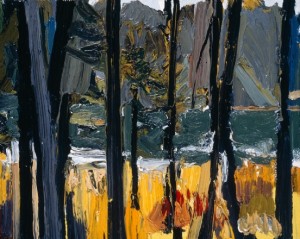 Between South Branch Road and Johns Bay, South Bristol, Maine, III; 1998; oil on canvas; 8 x 10 inches
Between South Branch Road and Johns Bay, South Bristol, Maine, III; 1998; oil on canvas; 8 x 10 inches  Between South Branch Road and Johns Bay, South Bristol, Maine, IV; 1998; oil on canvas; 8 x 10 inches
Between South Branch Road and Johns Bay, South Bristol, Maine, IV; 1998; oil on canvas; 8 x 10 inches Straight, 1999, oil on canvas, 30 x 40 inches.
Straight, 1999, oil on canvas, 30 x 40 inches. Drifts, 1999, oil on canvas, 30 x 40 inches
Drifts, 1999, oil on canvas, 30 x 40 inches Snow, Trees and Ocean, 1999, oil on canvas, 24 x 30 inches
Snow, Trees and Ocean, 1999, oil on canvas, 24 x 30 inches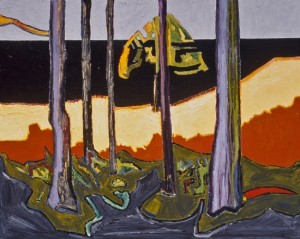 Trees and Ocean, 1999, oil on canvas, 48 x 60 inches
Trees and Ocean, 1999, oil on canvas, 48 x 60 inches Study of Straight, 2000, graphite on paper, 22 x 28 inches
Study of Straight, 2000, graphite on paper, 22 x 28 inches
I hung canvases on three sides of that little studio’s walls, looked out the sliding glass door and painted. My palette table was beneath the window. I had two ideas. The first one was to paint snow. And, the second was to see what effect the solitude might have on my work. As for the snow, there was precious little of it. A storm came: it snowed, moved on, stalled at sea, reversed course and, defying the odds, returned. The solitude was in abundance. I finished my probation.
 Woman and Man, Beneath an Umbrella, Standing at the Curb; 2004; oil on canvas; 40 x 30 inches
Woman and Man, Beneath an Umbrella, Standing at the Curb; 2004; oil on canvas; 40 x 30 inches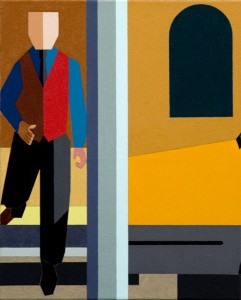 Reaching Out to Shake His Hand, 2004, oil on canvas, 20 x 16 inches
Reaching Out to Shake His Hand, 2004, oil on canvas, 20 x 16 inches
 Hook and Ladder 2, 2004, oil on canvas, 24 x 30 inches
Hook and Ladder 2, 2004, oil on canvas, 24 x 30 inches
Prior to that, my travel had been restricted. Outside of a certain radius and without authorization, I could not travel. Therefore, I used some of the award to finance a very brief trip to London to see my friend, Peter de Francia. I met him in New York in 1992, while a student of his, for a week, at The New York Studio School. Since, we had maintained a correspondence. Back in ’92, I had driven him to my studio, in Brooklyn; he had asked me to come to London; I had mentioned that I was unable to, as I was on probation; and he had replied, “All the best people are.”


